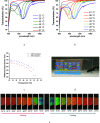Reversible Thermochromic Photonic Coatings with a Protective Topcoat
- PMID: 33406827
- PMCID: PMC7821277
- DOI: 10.1021/acsami.0c19236
Reversible Thermochromic Photonic Coatings with a Protective Topcoat
Abstract
The fabrication of reversible and robust thermochromic coatings remains challenging. In this work, a temperature-responsive photonic coating with a protective topcoat is fabricated. A cholesteric oligosiloxane liquid crystal possessing a smectic-to-cholesteric phase-transition temperature response is synthesized. A planar alignment of its cholesteric phase is possible with blade coating. By stabilizing with 3 wt % of a crosslinked liquid crystal network, the photonic coating shows a color change ranging from red to blue upon heating. High transparency is retained, and the structural color changes are fully reversible. A transparent polysiloxane layer can be directly applied on top of the cholesteric layer to protect it against damage without affecting its optical properties. This approach satisfies the basic requirements of thermochromic polymer coatings, as it combines easy processability, coating robustness, and a reversible temperature response.
Keywords: cholesteric liquid crystals; reflective coatings; stimuli-responsive photonic materials; structural color; thermochromic polymers.
Conflict of interest statement
The authors declare no competing financial interest.
Figures






References
-
- Parker R.Digital Thermometer and Method of Manufacture. U.S. Patent 3,861,213 A, 1975.
-
- Wang H.; Bisoyi H. K.; Wang L.; Urbas A. M.; Bunning T. J.; Li Q. Photochemically and Thermally Driven Full-Color Reflection in a Self-Organized Helical Superstructure Enabled by a Halogen-Bonded Chiral Molecular Switch. Angew. Chem., Int. Ed. 2018, 57, 1627–1631. 10.1002/anie.201712781. - DOI - PubMed
-
- Moirangthem M.; Stumpel J. E.; Alp B.; Teunissen P.; Bastiaansen C. W. M.; Schenning A. P. H. J.. Hot Pen and Laser Writable Photonic Polymer Films. Proceedings of SPIE 9769, Emerging Liquid Crystal Technologies XI, 2016; p 97690Y.
-
- Zeng R.; Chini A.; Srinivasan R. S.; Jiang P. Energy Efficiency of Smart Windows Made of Photonic Crystal. Int. J. Constr. Manag. 2017, 17, 100–112. 10.1080/15623599.2016.1207368. - DOI
LinkOut - more resources
Full Text Sources
Other Literature Sources

